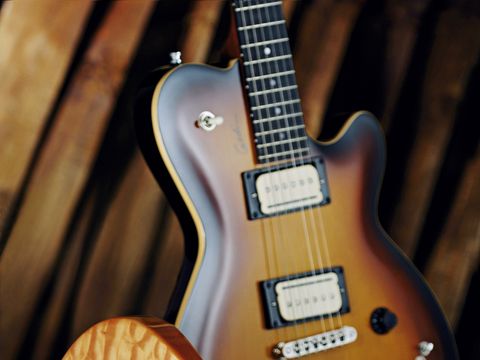Even a cursory click around the Godin website shows the huge array of electric guitars in the Canadian firm's catalogue.
The new model we have revisits a classic design, albeit with an unmistakable Godin twist - its first ever set-neck single-cut.
Build
So the Icon is Godin's first set-neck design as opposed to the more usual bolt-on models. Why now?
"We were waiting for the perfect guitar in our minds to release with this particular style of neck, and the Icon series guitars are those instruments," offers Godin's Richard Bunze.
"They're the perfect combination of craftsmanship and innovation, to whet the palette of any player who wants a very vibrant, resonant and electrifying guitar to bring down the house!" Indeed.
"Overall, the Type2 Convertible is well-balanced and lovely to play."
Aside from its set neck joint, the Type2 Convertible provides two of Seymour Duncan's most innovative recent pickups: the P-Rails. Effectively a P-90-style design with an additional 'rail' single-coil, the P-Rail, via a three-way mini switch, offers P-90 and rail single-coil sounds plus, when combined, a standard humbucking tonality.
With a mini switch for each pickup and a single three-way toggle selector, a wealth of pickup options are on offer. Most companies would probably leave the tonal options at that, but not Godin.
In addition, both the Icon 2 and Progression Boutique USB feature a small button that accesses the High-Definition Revoicer (HDR) circuitry.
"The HDR revoices and augments the frequency range of each pickup and allows the player to go from passive to active pickups with the push of a button," explains Bunze. "It provides extra bite, dynamic response and redefines the character of each pickup."
Powered by an internal nine-volt battery, you can switch it in and out for each and every pickup setting and, as we'll see later in the review, it has a marked effect on the tone.
The physical construction is more standard, although the material used for the Icon's carved top differs depending on what finish you opt for.
The natural version features a mahogany cap, while our sunburst's example is maple; what's common to all Icons is a chambered mahogany body for additional resonance.
The mahogany neck features the same slinky headstock used on the 5th Avenue archtop and the ebony fingerboard has undergone a process described as 'Ergo-Cutting' where the edges of the 'board are carefully sanded and bevelled inwards to give a somewhat worn-in feel - a nice, pseudo boutique touch.
Sounds
The P-Rails is a very powerful pickup and with the addition of the HDR circuit, tones can become very hot indeed.
To obtain what we'd describe as a traditional Les Paul-style classic rock rhythm tone, for example, we rolled a little of the tone off to help the smoothness.
The bridge pickup in humbucker mode eloquently provides that strident yet gainy Gary Moore sound and overall the Icon certainly has more cut than, for example, a Slash-style tone.
Engaging the HDR adds more mids and bite, although it falls short of the aggression of an EMG-89; combined with the bridge pickup's P-90 setting there's a spookily authentic Angus Young tone.
Clean settings are fat and full, and mixing the neck P-90 with the bridge single-coil provides a middly SG-style sound that's ideal for subtler blues passages.
Up the gain slightly and mix in the HDR here and there's more cut and high end added to the middly base. Think Pete Townshend armed with a boutique overdrive and his wall of HiWatts. In short, there are a lot of sounds here to explore.
The Type2, then, is well-balanced and lovely to play: an inspiring single-cut.
There's very little to dislike about the Icon, and if the relative complexity of P-Rails pickups and their switches puts you off, the Type2 Classic comes loaded with a Godin GHN1 humbucker in the bridge and a Seymour Duncan '59 in the neck.
However, such is the choice of tones available from the Convertible, we'd strongly recommend you give it a whirl. The chambered body ensures that it won't compromise your shoulder muscles and we honestly couldn't find a tone we didn't like.

